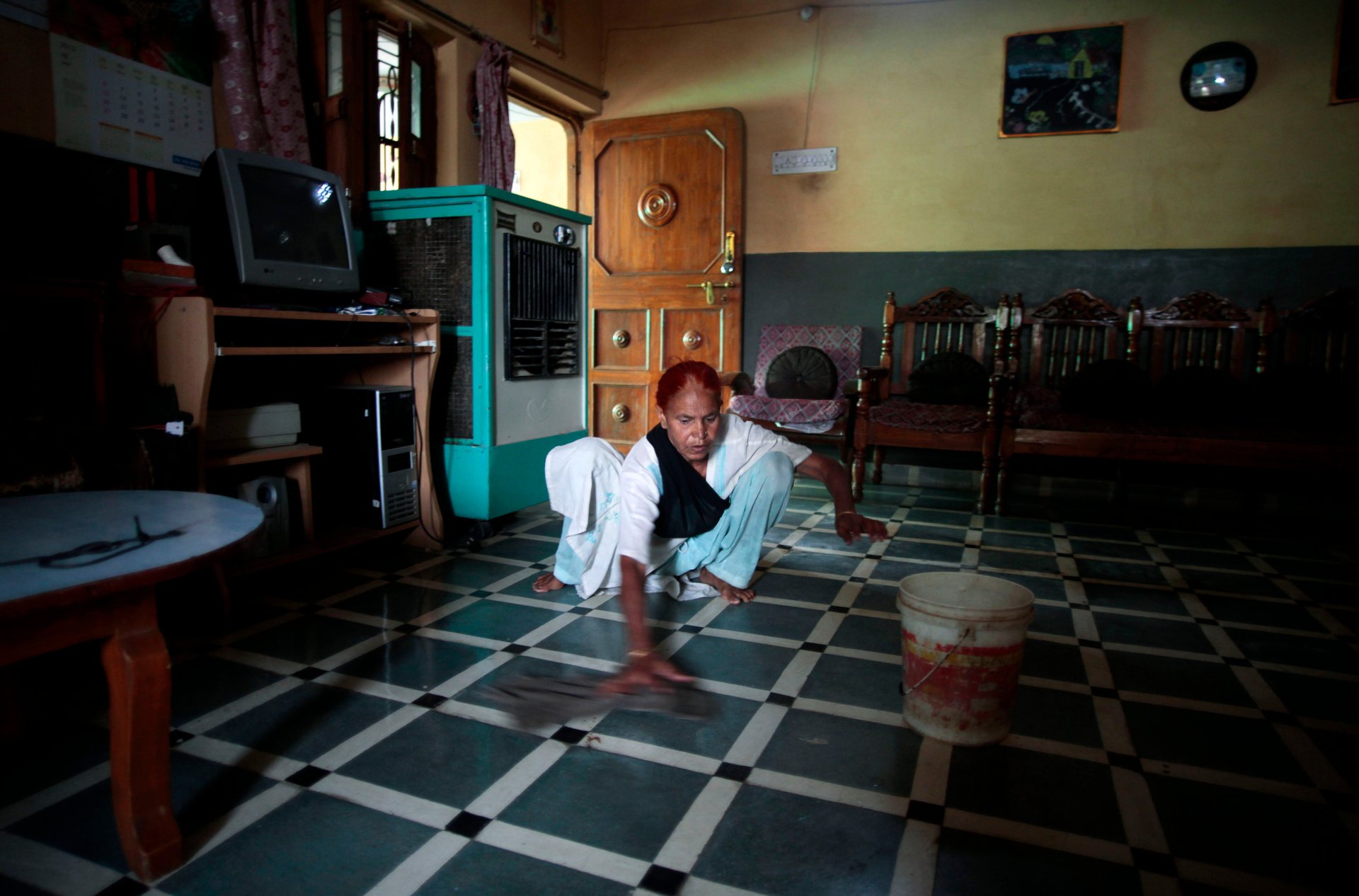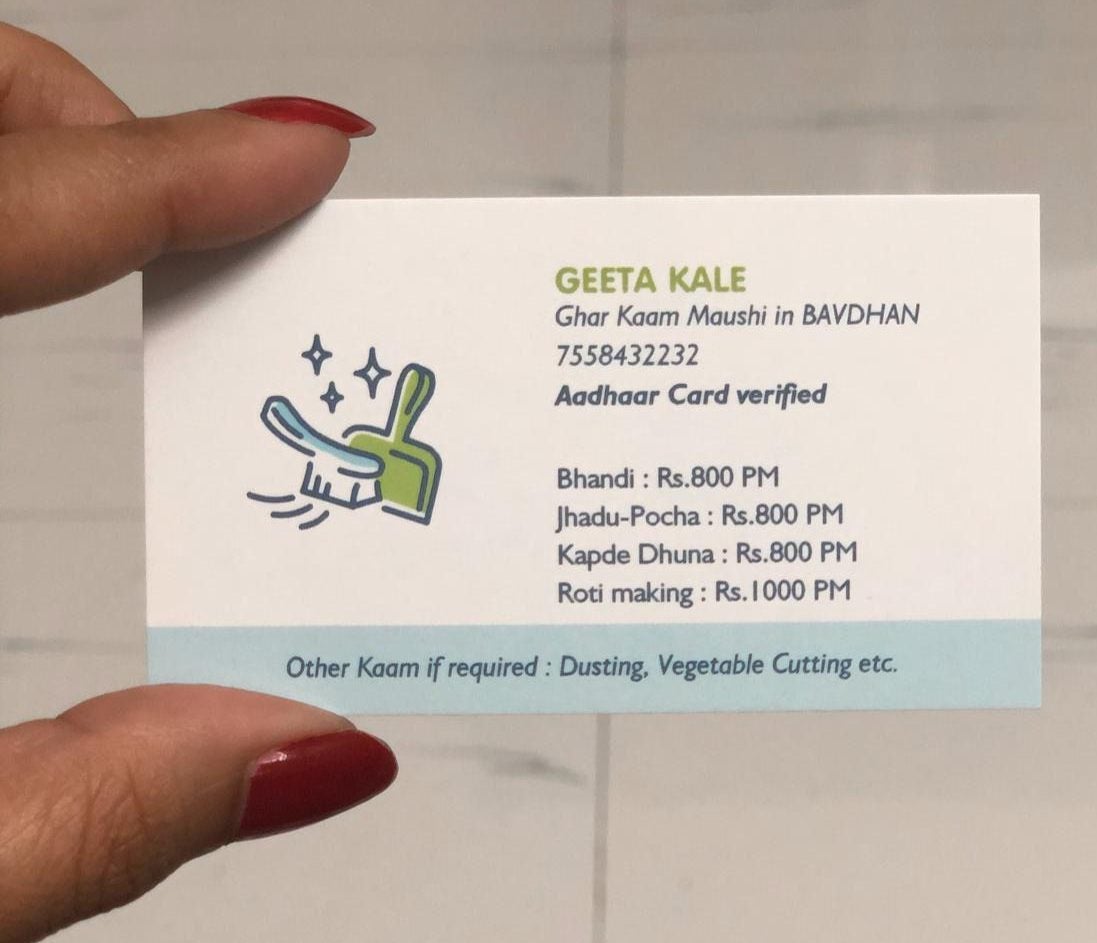You’ve probably seen Geeta Kale’s visiting card. Now, here’s the domestic help’s real story
Last week, a housemaid in the western Indian city of Pune lost one of her many jobs, only to be flooded by offers from across the country. All thanks to a small addition to her profile: a visiting card.


Last week, a housemaid in the western Indian city of Pune lost one of her many jobs, only to be flooded by offers from across the country. All thanks to a small addition to her profile: a visiting card.
Of the many households Geeta Kale has worked for every day for years—sweeping, mopping, cleaning utensils, dusting, etc—in Pune’s Bavdhan locality, one abruptly decided to end her service for reasons she did not want to discuss. This one family’s payment to her—Rs4,000 ($56)—made up for 40% of the 26-year-old’s monthly earnings.
Needless to say, Kale was distraught. “It’s not easy to find new work quickly,” she told Quartz. “Only if there’s someone who needs immediate help do you find work easily.”
Moved by her plight, another one of Kale’s employers, Dhanashree Shinde, suggested a minor tweak in strategy. A brand manager and digital marketer for a real estate firm, Shinde designed a simple visiting card, complete with Kale’s contact information, her repertoire of skills, and their rates—all in a curious mix of Hindi/Marathi and English.
“I just thought if I have my own visiting card, why not make one for Geeta as well?” Shinde said.
She placed an order for 100 cards with a local printer. On Nov. 6, Shinde clicked a photo of the card on her smartphone to circulate on WhatsApp groups and among other contacts.

Ever since, Kale’s phone has not stopped ringing or buzzing with WhatsApp messages.
The intent was to circulate the cards among security guards of residential communities in the area and send the pictures to a few acquaintances to get Kale a new job. However, it wasn’t long before the snap made its way back to Shinde’s own phone via WhatsApp.
The photo had gone viral.
To escape the deluge of requests, and often impolite inquiries, Kale switched her phone off for four days. Yesterday (Nov. 10), when she switched it on briefly to point out her dilemma to this reporter, WhatsApp messages came pouring in—they jumped from 1,515 to 1,877 in merely the first couple of minutes.
By then, local and national newspapers, television channels, and radio jockeys had turned her into a celebrity of sorts, her story quickly turning into a larger one of India’s exploited domestic workers.
Maid in India

Before setting off to work every day, Kale, who lives in a nearby labour camp in Bavdhan, wakes up at 4am to prepare food for her family of six. This includes her husband, a construction worker, and two school-going daughters.
“I can do all the household chores pretty easily,” Kale said nonchalantly, her answers in Marathi translated into English by Shinde.
She is representative of the 20 million such domestic workers across India (mostly women), whose life is defined by informality at every stage of the employment process, right from looking for a job to settling on a decent salary to earn a livelihood.
Consistently underpaid and exploited, housemaids fare worse than other workers in the informal sector, data from the latest National Sample Survey Office finds. For more than a decade now, the government has been working to draft a National Policy on Domestic Workers but is yet to pass meaningful legislation to officially bring these workers into the Indian workforce.
“Domestic workers in India are unprotected, poorly paid, and lack safety,” Amod Kanth, chairperson of Domestic Workers Sector Skill Council, a government organisation that trains domestic workers, told the Wall Street Journal in 2016. “They are considered servants, their work is servitude.”
Wages for housemaids in India vary wildly depending on location—cities like Mumbai, New Delhi, and Bengaluru command the highest monthly salaries for domestic workers.
A 2016 study by Babajob.com, a Bengaluru-based job-seeking platform for blue-collar workers, found that in India, housemaids earned less than all the other professions in the category (which includes cooks, nannies, drivers, and security guards, among others). While a driver in New Delhi could earn Rs12,500 ($175) a month, a maid in the city could secure only Rs6,000 ($84) in wages.
Negotiating a liveable salary, therefore, is a process that is largely out of the control of people like Kale. Local rates for household chores like cooking, washing utensils, sweeping the floor, and doing laundry are decided informally among the group working in a given area. The word travels quickly, establishing a quasi-official salary level for the locality’s maids. The only other factor that could otherwise determine their salary is the number of people to be serviced in a given household.
When asked if she got regular hikes, Kale said the decision is largely up to her employers. “I get my yearly Diwali bonus, but the monthly payment can increase only if the informal rates increase,” says Kale. Or if her employers choose to pay her more.
For Kale, the ideal job is one that pays well, is closer home, and is at an amiable household that treats her well. She refuses those who don’t meet these minimal requirements even offered a high salary.
Her brush with social media has had an ironic turn of events. The household that dropped her in the first place has now re-employed her. And that, too, without giving out a single one her visiting cards herself.
“It’s something quite extraordinary to people, isn’t it?” said Kale when asked why she thought the idea of a housemaid with a visiting card had exploded the way it had. “But I couldn’t tell you exactly why this has happened.”